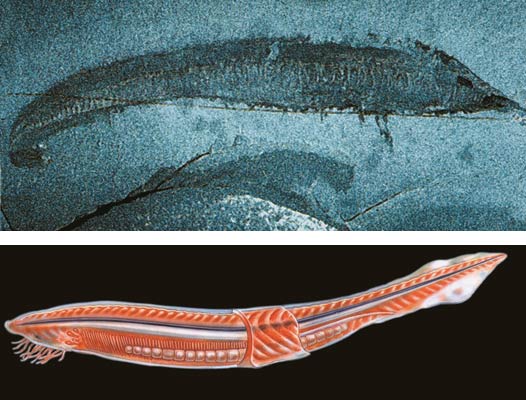Chapter 10. Evolutionists' Confessions Stating that There Is No Evidence of a Transition from Invertebrates to Vertebrates
Evolutionists claim that the invertebrate marine organisms that appeared in the Cambrian Period turned into fish over the course of tens of millions of years. But in the same way that none of the Cambrian invertebrates have any forerunners, there are also no intermediate forms to indicate any evolution between these invertebrates and fish. The fact is that the evolution of invertebrates-which have no skeletons and whose hard parts are on the outside of their bodies-into bony fish, whose hard parts are on the inside of their bodies, would be a transition on a giant scale (it requires change in many more anatomic details and complex structures), and countless traces of this should have been left behind in the fossil record.
Evolutionists have been digging up the fossil strata for the last 150 years in their search for these imaginary life forms. Millions of invertebrate fossils have been turned up, and millions of fish fossils. But nobody has yet come across a single intermediate form.
Gerald T. Todd is an evolutionist paleontologist:
All three subdivisions of the bony fishes first appear in the fossil record at approximately the same time... How did they originate? What allowed them to diverge so widely?... And why is there no trace of earlier, intermediate forms?223
J. R. Norman is in the Department of Zoology at the British Museum of Natural History:
The geological record has so far provided no evidence as to the origin of the fishes.224
Gordon Rattray Taylor is an evolutionist author and chief science advisor for the BBC:
... there are no intermediate forms between finned and limbed creatures in the fossil collections of the world.225
Dr. F. D. Ommaney is an English scientist of the 1930s:
How this earliest chordate stock evolved, what stages of development it went through to eventually give rise to truly fish-like creatures, we do not know. Between the Cambrian, when it probably originated, and the Ordovician, when the first fossils of animals with really fish-like characteristics appeared, there is a gap of perhaps 100 million years, which we will probably never be able to fill.226
 |
| A Pikaia fossil, one of the oldest known vertebrates, and its estimated anatomy |
Footnotes
223- Gerald T. Todd, "Evolution of the Lung and the Origin of Bony Fishes: A Casual Relationship," American Zoologist, Vol. 26, No. 4, 1980, p. 757.
224- J.R. Norman, "Classification and Pedigrees: Fossils," in A History of Fishes, British Museum of Natural History, 1975, p. 343.
225- Gordon Rattray Taylor, The Great Evolution Mystery, New York, L Harper and Row, 1983, p. 60.
226- F. D. Ommaney, The Fishes, Life Nature Library, New York: Time-Life, Inc., 1964, p. 60.
- Introduction
- Chapter 1. Charles Darwin's Confessions Regarding His Theory
- Chapter 2. Evolutionists' Confessions Regarding Darwin
- Chapter 3. Evolutionists' Confessions Regarding the Invalidity of the Theory of Evolution
- Chapter 4. Evolutionists' Confessions Stating that They Espouse the Theory of Evolution for Ideological Reasons
- Chapter 5. Evolutionists' Confessions Stating that Natural Selection has No Evolutionary Power
- Chapter 6. Evolutionists' Confessions Stating that Mutations Have No Evolutionary Power
- Chapter 7. Evolutionists' Confessions Regarding the Dead-End of Molecular Evolution
- Chapter 8. Evolutionists' Confessions Regarding the Sudden Emergence of Life
- Chapter 9. Evolutionists' Confessions Regarding the Lack of Intermediate-Form Fossils
- Chapter 10. Evolutionists' Confessions Stating that There Is No Evidence of a Transition from Invertebrates to Vertebrates
- Chapter 11. Evolutionists' Confessions of the Impossibility of a Transition from Water to Dry Land
- Chapter 12. Evolutionists' Confessions of the Impossibility of Reptiles Evolving into Birds
- Chapter 13. Evolutionists' Confessions Stating That the Theory of Evolution Cannot Account for the Origin of Mammals
- Chapter 14. Evolutionists' Confessions Regarding the Invalidity of the "Horse Series"
- Chapter 15. Evolutionists' Confessions Regarding the So-Called Forebears of Man
- Chapter 16. Evolutionists' Confessions Stating that the Human Soul cannot Be Explained in Terms of Evolution
- Chapter 17. Evolutionists' Confessions Stating that Complex Organs cannot Appear by Way of Evolution
- Chapter 18. Evolutionists' Confessions Stating that the Theory of Evolution cannot Explain Animal Instincts
- Chapter 19. Evolutionists' Confessions Stating that Plants Cannot have Arisen by Way of Evolution
- Chapter 20. Evolutionists' Confessions Regarding Variations
- Chapter 21. Evolutionists' Confessions Stating the Non-existence of Vestigial Organs
- Chapter 22. Evolutionists' Confessions Regarding the Invalidity of the Claims of Homology
- Chapter 23. Evolutionists' Confessions Stating that the Evolution Theory Violates the Second Law of Thermodynamics
- Chapter 24. Evolutionists' Confessions Regarding the Invalidity of the Theory of Recapitulation
- Chapter 25. Evolutionists' Confessions Stating that Life Can Only Have Been Created
- Chapter 26. Materialists' Confessions Stating that the Universe Has a Beginning
- Chapter 27. Evolutionists' Confessions Stating that the Order in the Universe Cannot Have Come about by Chance
- Chapter 28. Evolutionists' Confessions Regarding Darwinism's Negative Effect on Moral Values
- Conclusion
